Home > Alabama > Red Land Cotton Handcrafts Cotton Linens From Field to Fabric
Red Land Cotton Handcrafts Cotton Linens From Field to Fabric

The word “heirloom” isn’t a word most people associate with linens these days. If you’re buying sheets online or from a big-box store, you’re generally lucky if you get a few good years sleeping on them before they start to pill or tear. However, one company in Alabama is out to change the way people think about bedding.
Mark Yeager and Anna Yeager Brakefield are the father-daughter team behind Red Land Cotton, a field-to-fabric manufacturer producing heirloom-quality bedding and bath linens made from the cotton grown on their farm in Moulton, Alabama. When you receive a set of these sheets, they look and feel different than you’re probably used to. Crisp, delicate-yet-sturdy and artfully made, they have the quality of a vintage fabric that can be passed down for generations. With each order, an included card showing a map of Alabama, Georgia and South Carolina shows precisely each step: where they’ve been grown, sewn, woven, spun and finished – helping you to feel instantly connected to the process and the makers behind this farm-to-fabric brand.
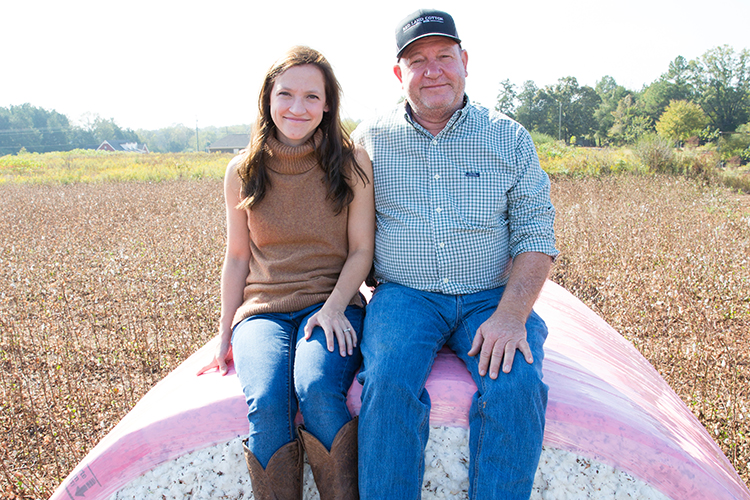
The Foundational Farm
Mark’s father, Dallas Yeager, originally bought the farm back in the 1970s. It was more of a hobby farm, Anna says – and at the time, that was a good thing, as only one of six children (Mark) wanted to pursue farming. He officially began Red Land Farms in 1983 and eventually grew it from a couple hundred acres into 5,000 acres. About 3,300 of those are cotton fields, but he also dabbles in soybeans and corn, and owns cattle, too. In 1994, he built the cotton gin that still stands on the farm today.
Throughout the expansion of the farm, the family has always kept stewardship in mind. “[My dad] has always tried to do what’s best by the land as he continues do increasingly own more of it,” Anna says. Today, the farm’s cotton is still entirely rain-fed and produced under the most current sustainable farming techniques, such as no-till farming, organic fertilizer and cover crops.
See more: From Field to Fabric: How Cotton is Grown
Around 2015, Anna was living with her husband in Nashville, having built a career in marketing and advertising. She was ready for a new challenge at the same time her father started thinking about ways to create a consumer-facing good out of his cotton. The idea enthused Anna, so she put together a supply chain and ideas around logistics. About six months later, she officially quit her job to work with her dad on launching the Red Land Cotton business.
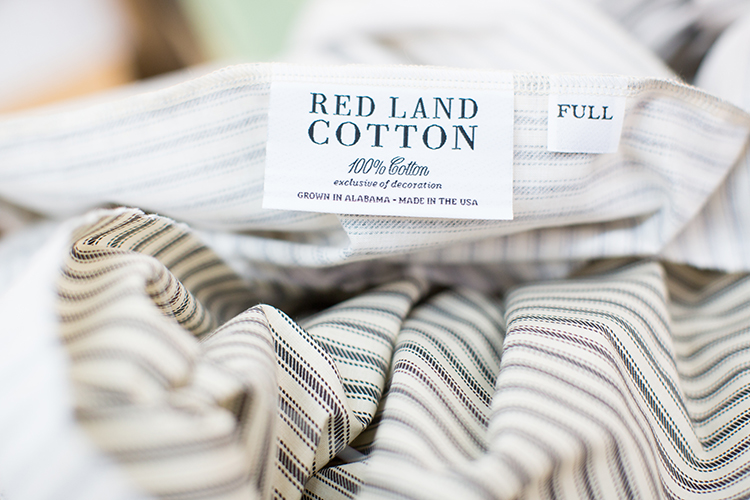
From Field to Fabric
Northern Alabama’s red clay soil and the name of the original farm helped inform the name of the company, Red Land Cotton. “That created the foundation to be really soulful and about the farming aspect of [cotton],” Anna explains. It was also important to Mark to retain the foundation of everything he’d built with the farm throughout the new brand.
As they got into researching the process of making sheets, one major factor stood out: “[When we saw] what it would cost to make this product, we knew that to create more value, we needed to show how we were growing and manufacturing our cotton,” Anna explains. “[Demonstrating] the ethics and work going into it [is what would] really make it valuable.”
She started to build the brand by creating a lot of content – such as photos and iPhone videos for Instagram and YouTube, showing the cotton fields and their process on the farm – and that’s been a major factor in their success. “Our family being in cotton is the base of it, and this revitalization of American manufacturing we’re trying to talk about [comes into play] as well,” Anna says. “We are sharing our priorities when it comes to sustainable farming and American manufacturing, and that seems to really resonate with our customers,” Anna says.
See more: Babydolls, Blooms and Beauty: A Trip to 1818 Farms in Alabama
So how do Red Land Cotton sheets differ from the ones you’d buy at your average department store? For one, most other sheet brands are not made in the U.S., and they also rarely have transparency about where and how their cotton was grown or harvested. Red Land Cotton seeks to be the opposite, being “exceptionally transparent” about the product and the production process, as well as the family growing the cotton, Anna says. On the company’s website, you can see photos and watch videos showing every step along the way, and even hear from women in Alabama who cut and sew the sheets.
“For us, there are faces and places you can associate with our product, whereas a random sheet set you can pick up off the shelf is lacking that,” Anna adds.
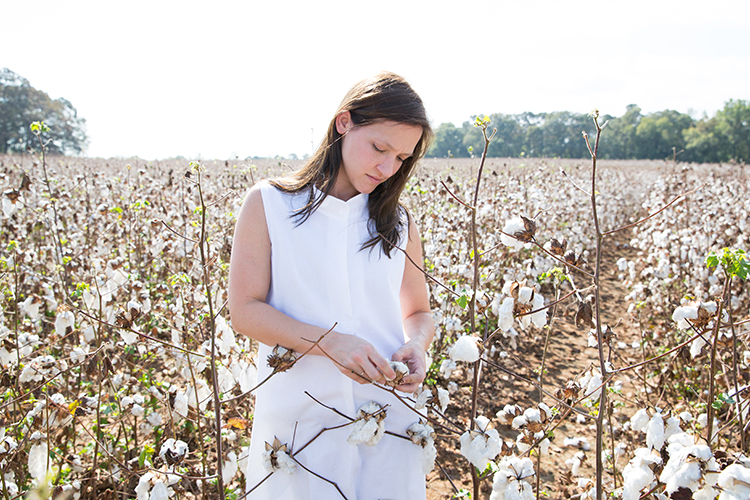
Diminishing Cotton Fields
There aren’t nearly as many cotton fields in Alabama – or the U.S., for that matter – as there used to be. American cotton farms have fallen by half in less than two decades, according to the USDA’s Census of Agriculture; in Alabama alone, there were only 874 cotton farms in 2017 compared to 1,600 cotton farms in 1997. (The size of cotton farms, however, has increased.)
A few years ago, Anna says her family noticed a significant drop-off in the number of cotton farms in their area. The cost of starting up a new cotton farm has been a factor, too: As the older generation is falling out of farming, unless they have children wanting to carry it on, Anna says she thinks more cotton fields will be sold off for development.
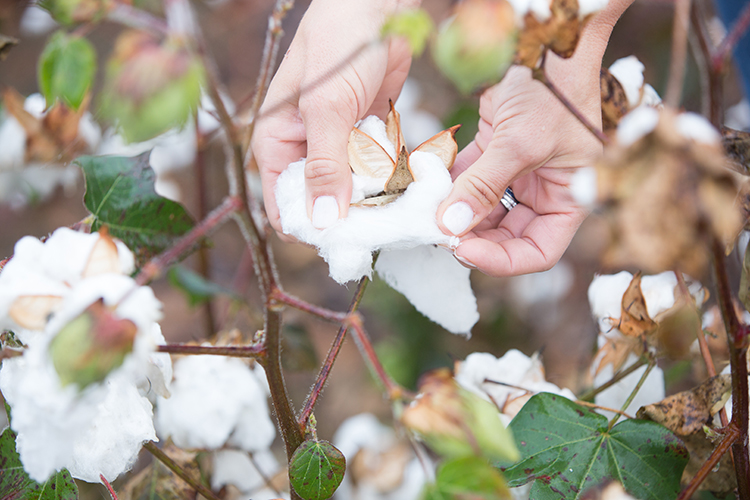
The volatility of trade overseas, especially with China, plays a role as well. “Cotton prices are still so low because domestically, there is still no manufacturing at all,” Anna says. “All the cotton the U.S. produces has to be shipped away – so that’s a cyclical issue.”
While these factors combined don’t bode well for cotton farmers in general, they have helped bolster Red Land Cotton’s business. Low prices were the main driver for Mark to want to diversify his business in the first place, and being one of very few cotton producers manufacturing their own product in the U.S. has helped set them apart. While they have encountered issues in their supply chain along the way by being committed to producing 100% American-made products, it hasn’t been a deterrent for Anna and Mark. “[The supply chain] is definitely the greatest challenge,” she says, “but I think it’s key to our story and what our product and business is.”
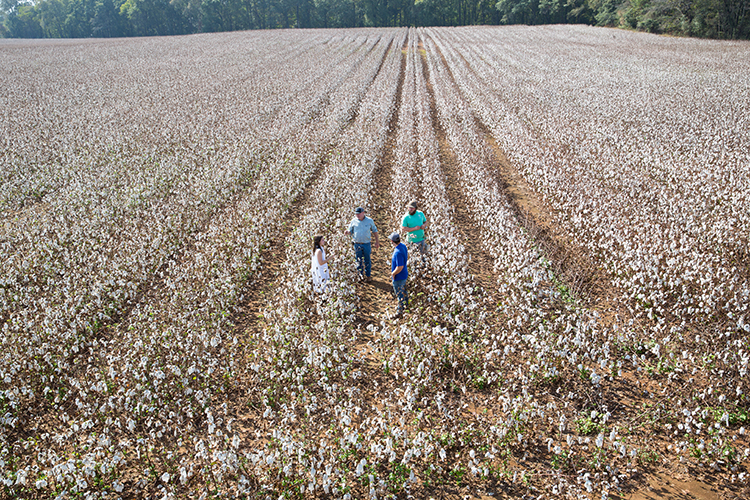
Working Together as a Family
Anna’s two brothers help her father farm, and she and her dad work together closely every day. It isn’t always easy, but she wouldn’t have it any other way. “Sometimes you say [silly] things, but your family still loves you anyway,” she notes. She’s gained a lot of her business intel from her dad, though he’s OK when they disagree, too. “He respects the marketing opinions that I have,” says Anna.
One of her best marketing moves has been Red Land Cotton’s highly professional website and digital content, which includes a newsletter, an insightful blog focused on the home, dozens of reviews, guides to buying natural cotton bedding, and resources on the benefits of buying American-made bedding (among them: supporting local agriculture and impeccable quality!). Anna has also added a registry feature, perfect for engaged couples.

The company is primarily direct-to-consumer, though they have partnered with a few bed and breakfasts and Airbnb rentals. “We’ve found a lot of good marketing there, too – people trying out the sheets [while staying there] and then buying them from us,” Anna says. (Beside the beds, she’ll leave little cards detailing what the guest is sleeping on and where they can get their own sheet set.) One hundred percent cotton products don’t withstand high heat, she notes, so they’re not ideal for hotel bedding (which would need to be sanitized regularly).
See more: United States Cotton Facts
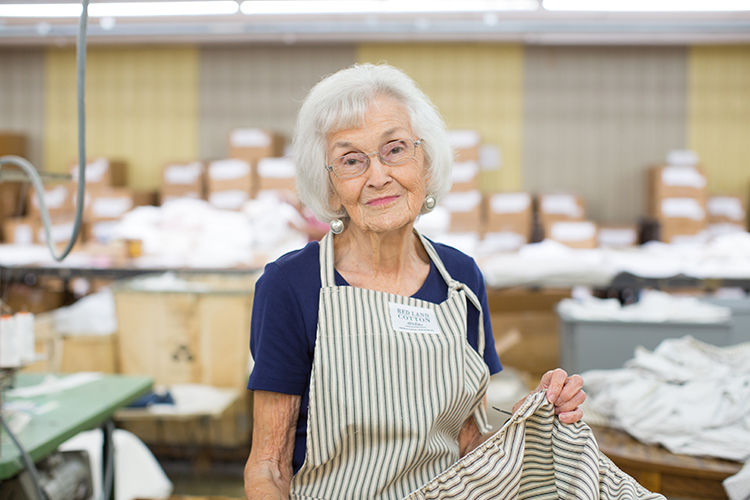
Looking ahead, Red Land Cotton is planning to introduce a new line of blankets made from North Carolina-spun yarn and woven in Maine. They’re also launching a bathrobe made from the same terry as their towels, plus a new gray line of sheets and towels. Each new product addition comes from listening to their customers and hearing what they want to see next.
Red Land Cotton started from nostalgia – the feeling of remembering what it felt like to sleep on the sheets at your grandmother’s well-kept home – and continues in that way, too. “These are heirloom products that were built to last,” Anna says. “People really love them.”




Red State linen with Blue state prices. get serious!
Good. Let’ us save the earth with organic cotton production
Where can I purchase these linens?
Hi Suzanne,
You can purchase them online at https://www.redlandcotton.com/
Thanks!
Rachel Graf
Digital Editor, Farm Flavor
Saw the commercial on FOX and immediately went online to make sure RLC is actually an American corporation using goods sourced from and manufactured in the USA. Despite the first comment by Mr. Y at the beginning of this post I think my red blood will give the family company a try.
It’s great that Red Land has many traditional farming practices and that they produce what they say is an heirloom product. But it wouldn’t be fully heirloom unless they use heirloom, non-gmo seeds. Do they grow from actual heirloom cotton seeds? And what about pesticides… what type do they use, if any, and are the pesticides used allowed within organic certification guidelines?